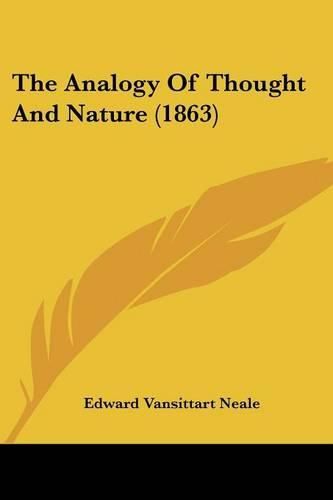Readings Newsletter
Become a Readings Member to make your shopping experience even easier.
Sign in or sign up for free!
You’re not far away from qualifying for FREE standard shipping within Australia
You’ve qualified for FREE standard shipping within Australia
The cart is loading…






Purchase of this book includes free trial access to www.million-books.com where you can read more than a million books for free. This is an OCR edition with typos. Excerpt from book: CHAPTER II. The Characteristics of Thought. The course of reasoning indicated in the last chapter naturally commences by an inquiry into the general character of the operations carried on in our intellects. For if, as has been suggested, there be a law of thought, we shall thus probably be put upon the road to its discovery. If we examine the process of thought in our own minds, we may detect in it a twofold operation: the first, constructive, by which we present to ourselves objects of thought composed of different parts; the second, analytical, by which we dissect these objects, or their parts, and contemplate the results of our dissection in their mutual relations, for the purpose of tracing out the bond or principle of union existing among them. This description applies to all thought, whatever the number of objects comprised in its operations: for to compare any objects we must first bring them together in thought, and thus construct a new unity out of them. It applies alike to the profoundest and the most instinctive exercises of thought. To test the truth of this statement we will begin with the latter, with the thoughts concerned in the perception of natural objects. Let us imagine that we see a mass of green or dark blue tints, of various shades of intensity, partly limiting each other, partly limited by bright blues or reds or some other color, and forming what we call a landscape. To give to this perception an intelligible shape, we must dissect the mass of colors, and arrange them in thought. Some we throw together, and refer to a common principle ofconnexion. Others we reject from this bond, and refer to another principle, and say, suppose,
I see a tree standing out against the sky, or against a grassy hill, or against some other background, as the ca…
$9.00 standard shipping within Australia
FREE standard shipping within Australia for orders over $100.00
Express & International shipping calculated at checkout
Purchase of this book includes free trial access to www.million-books.com where you can read more than a million books for free. This is an OCR edition with typos. Excerpt from book: CHAPTER II. The Characteristics of Thought. The course of reasoning indicated in the last chapter naturally commences by an inquiry into the general character of the operations carried on in our intellects. For if, as has been suggested, there be a law of thought, we shall thus probably be put upon the road to its discovery. If we examine the process of thought in our own minds, we may detect in it a twofold operation: the first, constructive, by which we present to ourselves objects of thought composed of different parts; the second, analytical, by which we dissect these objects, or their parts, and contemplate the results of our dissection in their mutual relations, for the purpose of tracing out the bond or principle of union existing among them. This description applies to all thought, whatever the number of objects comprised in its operations: for to compare any objects we must first bring them together in thought, and thus construct a new unity out of them. It applies alike to the profoundest and the most instinctive exercises of thought. To test the truth of this statement we will begin with the latter, with the thoughts concerned in the perception of natural objects. Let us imagine that we see a mass of green or dark blue tints, of various shades of intensity, partly limiting each other, partly limited by bright blues or reds or some other color, and forming what we call a landscape. To give to this perception an intelligible shape, we must dissect the mass of colors, and arrange them in thought. Some we throw together, and refer to a common principle ofconnexion. Others we reject from this bond, and refer to another principle, and say, suppose,
I see a tree standing out against the sky, or against a grassy hill, or against some other background, as the ca…